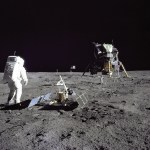Life on Mars
You certainly didn't hear it here first: today NASA, at a press briefing, announced that minerals analyzed by the Curiosity rover indicate that life might, in the galactic past, have survived on Mars. The rover's been poking around an ancient network of stream channels descending from the rim of Gale crater since September of last year; now, after drilling into the sedimentary bedrock nearby, it's hit on a treasure trove of life-supporting minerals: carbon, oxygen, hydrogen, phosphorus, sulfur, and nitrogen. These mineral findings are really just icing on the cake, as the geological…
"The achievements of Apollo were so bold and our subsequent efforts so timid that the energy of those years seems like a youthful dream." -Buzz Aldrin
43 years ago today, humanity took our first steps on another world, venturing nearly 400,000 kilometers from home and walking on the surface of the Moon.
Image credit: NASA, Apollo 11, photo by Neil Armstrong.
Of course, what we found there was a world whose soil was very similar to our own, but devoid of any atmosphere, liquid, or signs of life, present or past. But out beyond the Moon, visible in the distance even when viewed from Earth,…
A computer model of the formation of Olympus Mons (a big giant mountain on Mars) indicates that this geological formation should contain pockets of water.
The scientists explained that their finding is more implication than revelation. "What we were analyzing was the structure of Olympus Mons, why it's shaped the way it is," said McGovern, an adjunct assistant professor of Earth science and staff scientist at the NASA-affiliated Lunar and Planetary Institute. "What we found has implications for life - but implications are what go at the end of a paper."
This water would be liquid. Warm, in…
People love to speculate that Mars was once a great place for life to form, and claim that there is plenty of evidence that there used to be oceans and rivers there. But this isn't true. People used to claim there were big Canal-like features on Mars, and used this as evidence that Mars was very wet.
It was later realized that these weren't canals, but rather geological features caused by impact craters from astroids. But more recently, people have been claiming that images like the one above are examples of dried-up riverbeds.
But this turns out not to be the case. When we take a closer…


